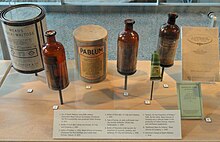Pablum

Pablum is a processed
Developers of Pablum included Canadian
Name
The trademarked name is a contracted form of the Latin word pabulum, which means "foodstuff". The word "pablum" had long been used in botany and medicine to refer to nutrition or substances of which the nutritive elements are passively absorbed. In a broader sense, "pablum" can refer to something that is simplistic, bland, mushy, unappetizing, or infantile.
Description
Pablum Mixed Cereal was made from a mixture of ground and precooked
of any kind, while it does contain wheat and corn, which can be allergenic for some.History
Pablum was developed in 1930 by Canadian
Although neither Pablum nor its biscuit predecessor[5] was the first food designed and sold specifically for babies, it was the first baby food to come precooked and thoroughly dried. The ease of preparation made Pablum successful in an era when infant malnutrition was still a major problem in industrialized countries.[6]
For a period of 25 years[
See also
- Baby food
- Infant formula
- Genericized trademark
- List of Canadian inventions and discoveries
References
- ^ Canadian Studies at Mount Allison University. 2001. Archived from the originalon September 1, 2009. Retrieved January 12, 2010.
- ^ a b "Harry H. Engel". The New York Times. Associated Press. April 2, 1984. Retrieved July 7, 2021.
- PMID 13367900.
- PMID 13184358.
- PMID 20317679.
- ^ "History of Pablum". Canadiana Connection. March 12, 2012. Retrieved June 17, 2020.
External links
 The dictionary definition of pablum at Wiktionary
The dictionary definition of pablum at Wiktionary
